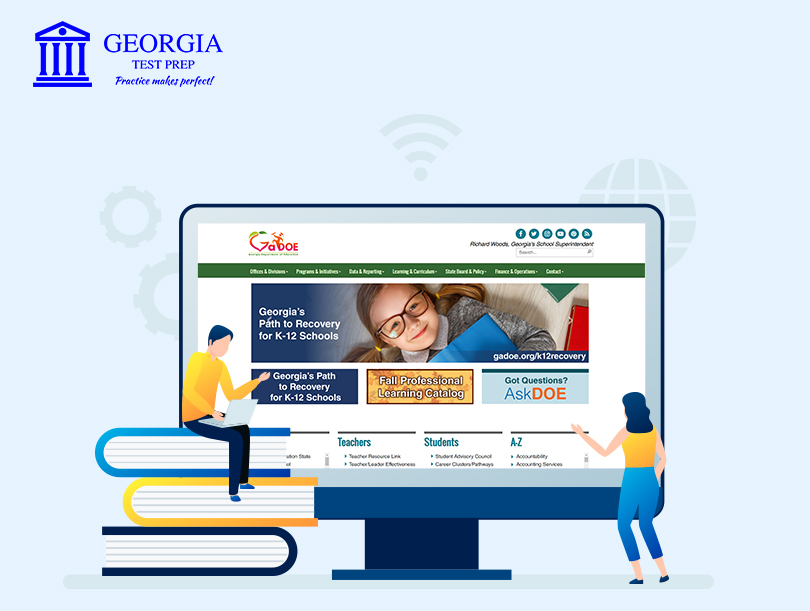If you’ve got a child in the Georgia state school system, then you’ve probably heard of the Georgia Milestones Assessment System and how important it is. They can indeed influence how your child progresses through school. But what exactly is it, and what does it mean? And as a parent, how can you help your children do well on it?
This post is a comprehensive guide on what the Georgia Milestones Assessment System (GMAS) is all about.
What is the GMAS?
Simply put, the Georgia Milestones is an assessment program for school children from grades 3 through high school.
The tests provide information about whether students are grasping their subjects according to the state-adopted standards in the core areas of English language arts (ELA), math, science, and social studies, and whether they are ready to progress to the next grade.
They offer a “snapshot” of what students can do in those subjects. But they are also important for school and district accountability. Informing the students, parents, educators, and the public about how well students are learning important content is an essential aspect of any educational assessment and accountability system.
The Georgia Department of Education (GaDOE) is the authority for Georgia Milestones.
History of GMAS
The Georgia Milestones Assessment System was introduced in 2014-2015 to replace former state assessments which were setting lower standards for students.
In fact, the old tests – the Criterion-Referenced Competency Tests (CRCTs) and high school End of Course Tests (EOCTs) –set some of the lowest expectations for student proficiency in the nation.
The Georgia Milestones are more rigorous and more in line with the rest of the country. In that way, they are a better system because they urge our students to do better.
Part of what makes them a better assessment than older tests is that they require “constructed responses,” meaning students must provide the correct answer instead of selecting it, or they might have to explain how they got the answer or even explain why a provided answer is wrong.
Features of GMAS
- Items in ELA and math are open-ended, i.e. they are constructed-response types for all grades and courses.
- The ELA assessment has a writing component that is in response to passages read by students at every grade level.
- All content areas and courses have norm-referenced items to compare how students fare at a national level (see National Percentile in Grading).
- The number of questions in the tests (30-60) and the allotted time to each test (60-90 minutes with breaks between sections) vary by subject.
Educators say that the GMAS isn’t the kind of exams students can study for with a cram session the night before the tests. It takes a sustained effort over the school year and requires students to pay attention in class and as they do their assignments.
We’ve covered in an extensive article what parents can do to help their kids prepare for the GMAS. If you find your child is getting stuck often, there are things you can do to remedy that as well. Check out the rest of our blog for more tips and information.
Who takes the GMAS?
All students from grade 3 all the way up to high school take the GMAS.
Grades 3 – 8 will take the End of Grade (EOG) assessment.All students who are enrolled in high school courses will take the End of Course (EOC) assessments.
Middle school students who are enrolled in a high school course are required to take the EOC assessment for that course and not the EOG assessment.
- Grades 3, 4, 6, and 7 take EOG assessments in ELA and math.
- Grades 5 and 8 take EOG assessments in ELA, math, science, social studies.
- High School students take EOC assessments for each of the ten courses designated by the State Board of Education across four content areas (listed below).
The EOC tests are administered at the completion of the course for all grades. Additionally, since the 2015-16 school year, these test results serve as the final exam for their corresponding course, and contribute 20% to a student’s final course grade.
Language Arts
- Ninth Grade Literature and Composition
- American Literature and Composition
Math
- Algebra I/Coordinate Algebra
- Geometry/Analytic Geometry
Science
- Biology
- Physical Science
Social Studies
- United States History
- Economics/Business/Free Enterprise
Why the GMAS matters
The GMAS is important for all the stakeholders, i.e. students and the schools.
These tests determine if the student has understood the curriculum as per state standards, because they are pegged to Georgia’s new academic standards, which are guided by the Common Core, a national consensus of what each child should learn in each grade level.
They are also used to determine whether students in certain grades are promoted or retained:
- 3rd graders must pass the English subject test to be promoted to 4th grade.
- 5th and 8th graders must pass the English and math portions to be promoted to the next grade.
- For high school students, each EOC score counts as 20% of their final grade in that course.
The GMAS tests are also used to determine the state’s rating system for its public schools because they are part of the formula that produces the College and Career Ready Performance Index.
When is the GMAS taken?
Grades 3-8 take the EOGs annually in the spring, typically in April.
Middle and high school students who are enrolled in a course that has an EOC will take the EOC when the course is completed, regardless of the grade level.
Retest for the GMAS
Should students need it, a retest is available during the summer. Check with your school for the exact schedule.
Generally speaking, the following students can take a retest:
- Students in grades 3, 5, and 8 who score Below Grade Level on the reading section of the ELA EOG test.
- Students in grades 5 and 8 who score at the Beginning level on the Math EOG test (see more about scoring levels later in this article).
- Students who earn a grade conversion score below 70 on a high school EOC test may retest during the next mid-month testing window, or during the summer if the first test was taken in the spring.
How is GMAS taken?
The GMAS is taken online unless students cannot interact with a computer due to their disability and their Individualized Education Plan requires a different accommodation. The state’s education department mandated online tests for all of its standardized tests from the 2018-19 school year.
Grading of the GMAS
Achievement Level
The achievement levels describe how well students have learned the knowledge and skills in the subject as per Georgia’s content standards, and give an indication of how ready a student is to move on to the next grade level. They also indicate how much academic support is needed to prepare the student for the next grade level or course and to be on track for college and career readiness.
Georgia Milestones reports student achievement in four levels:
- Beginning Learners: Proficiency in the course is not demonstrated. Substantial academic support needed.
- Developing Learners: Partial proficiency in the course is demonstrated. Additional academic support needed.
- Proficient Learners: Proficiency in the course is demonstrated. The students are prepared for the next grade level or course and are on track for college and career readiness.
- Distinguished Learners: Advanced proficiency in the course is demonstrated. The students are well prepared for the next grade level or course and are prepared for college and career readiness.
Lexile measures
A Lexile measure is an indication of reading level. It is a standard score that matches a student’s reading ability with difficulty of text material.
It can be interpreted as the level of book that a student can read with 75% comprehension. Experts have identified a 75% comprehension level as offering the reader a certain amount of comfort and yet still offering a challenge.
The Lexile scale ranges between 200L and 1700L. However, some students may score a Lexile reading of below 200L for some reading material and may have a code of BR* for “beginning reader”.
Many books have a Lexile measure to identify material that is at an appropriate reading level for a student or to identify material that would provide a challenge to improve their reading skills.
National Percentile
The EOG assessments include a small number of questions in each content area that are used in assessments nationally. These items give a general snapshot of how a student’s answers compare with students nationally. The percentile number indicates that your child performed as well as or better than that percent of the national sample.
Here is a sample of an Individual Student Report for the GMAS, and a parent’s guide to the Individual Student Report.
The Georgia Alternate Assessment (GAA)
The Georgia Alternate Assessment (GAA) is a key component of the Georgia Milestones Assessment System. It is for students with significant cognitive disabilities, and is an alternate assessment based on alternate achievement standards, as determined by the students’ IEP team.
Under the No Child Left Behind Act of 2001 (NCLB) and the Individuals with Disabilities Education Act (IDEA), states must ensure that all students, including students with significant cognitive disabilities, be taught a curriculum that represents sufficiently challenging academic standards.
What’s in store for the 2020-21 school year
As things stand, the GMAS is most likely going to be conducted for the 2020-21 school year. Although the state of Georgia had moved for the suspension of the 2020-21 GMAS and CCRPI school and district rating, the official word from the U.S. Department of Education is that there is no plan to grant federal testing waivers for the 2020-21 school year.
This is the first school year since the COVID -19 situation, and we know that this is going to be a tough and unprecedented one for students, teachers, and parents. Nonetheless, we will have to prepare for things as per the decision of the U.S. Department of Education. Please follow the official Georgia Department of Education (GaDOE) site for the latest updates.
As parents, what we can do is commit to continue practice testing to ensure that our children are prepared. Given that schools will be hard pressed as it is to make sure that classroom instruction is adequately given, extra practice testing becomes even more important. It’s also worth noting that science has shown that practice testing is an essential part of learning and increases long-term retention of subject matter and concepts. Practice makes everything stick.
Georgia Test Prep is an online practice testing tool to help your kids test themselves on what they learn in school. It’s designed by Georgia teachers and based on the Georgia school curriculum, so it’s super relevant to what your kids actually learn. Get access to thousands of questions for less than ten cents a day, and give your child a jump start on their success.


